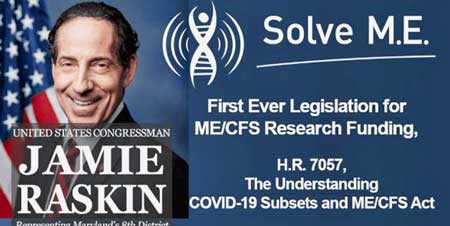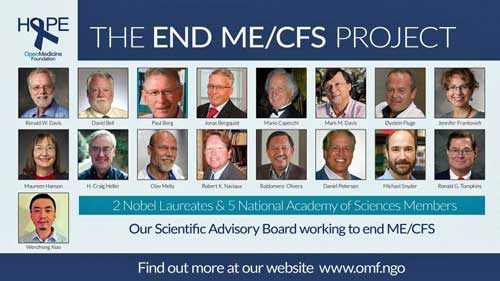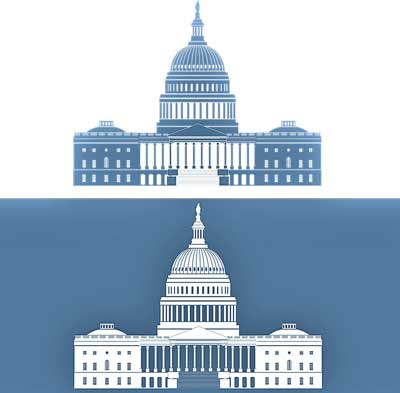

Opportunity and Danger
It’s getting to crunch time. This is a time of both opportunity and a time of danger. The coronavirus situation – as tragic as it is – is nevertheless providing a unique opportunity for the chronic fatigue syndrome (ME/CFS) field. It presents the possibility of ME/CFS being aligned with the health issue of our times. A window of opportunity has opened and our ability to step through it and garner as many resources as possible could very well be a defining moment (or not) for this illness.
With the enormous debt the U.S. is piling on and the severe economic downturn, though, the federal budget is also going to be squeezed like it rarely has been before.
Some good studies are underway, but right now the feds are focused on getting through the immediate crisis. There’s no indication yet that the NIH is interested in the part of the crisis that pertains to ME/CFS – the “long haulers” who’ve been able to fight off the virus, yet have been unable to recover fully.
The NIH does not appear interested in producing a major grant opportunity (RFA) to study those people. While some grant applications to do so are making their way through the system, the NIH is currently more focused on the understanding of the effects of hospitalization and lung damage: once again, it seems quite possible that ME/CFS could get lost in the mix.
Despite the fact that Anthony Fauci could use the long hauler situation to get younger people to be more careful, it took a direct question from ME Action’s Terri Wilder to Anthony Fauci to get him, for the first time, to publicly address the fact that many people who have fought off the virus remain ill.

Emily Taylor’s first goal has always been to get Congressionally mandated funding for ME/CFS at the NIH. That goal is now within reach.
The fact that the NIH is being the NIH should come as no surprise. Our voice carries little weight there. We’re still an afterthought.
The possibility that something big, bad and scary would come along that would knock ME/CFS funding out has worried Emily Taylor, the Solve ME/CFS Initiative’s (SMCI) full-time advocate, since she first stepped in the doors of the SMCI offices four years ago.
Our NIH funding, she explained, is currently discretionary. Meaning, those dollars are spent entirely based on NIH leadership decisions and are not guaranteed by law. Yes, we need to expand funding – but we also need to find a way to protect our funding.
Protecting and expanding funding are two reasons why getting Congressionally mandated funding at the National Institutes of Health (NIH) has been Taylor’s big goal since the beginning.
The Ultimate Decider: Congress
Congress, it turns out, does a lot more than allocate funding to the NIH. It actually plays a quite creative role. Emily stunned me when she said that most of the major NIH initiatives – from the Brain Initiative to the Heal Initiative to the All of US project, and even the Shark Tank COVID-19 testing initiative – were created with funding specifically allocated by the Congress or the President to the NIH.
The NIH, then, doesn’t really “invest” in diseases – unless it does so by congressional mandate. It doesn’t really care if the money goes to one disease or another, and it’s certainly not interested in addressing funding inequities. It’s not a particularly creative or fast-moving institution.
Even when decades of ME/CFS research potentially holds the clue to understanding what may be happening to hundreds of thousands of formerly healthy and productive post-COVID patients, the NIH is still not interested in ME/CFS. Emily Taylor hit it on the head when she spoke about how improved funding for ME/CFS could help ME/CFS patients and COVID-19 survivors.
“By rapidly mobilizing this research at the NIH, we hope to find answers that will help millions of COVID-19 survivors, including those who are already showing post-viral fatiguing and neuroimmune symptoms. Hopefully, this research will also identify viable treatments for the estimated 2.5 million Americans already suffering with ME/CFS.”
The COVID-19 crisis, it should be noted, has stopped work on the strategic plan for ME/CFS.
A Line-Item for ME/CFS
The situation is different at the Centers for Disease Control (CDC). CDC funding for ME/CFS is a federally mandated line-item in the federal budget. The CDC has to spend that money on ME/CFS. (Years ago they decided not to – and got into big trouble.)
That line-item provision is priceless because it provides us the opportunity to enroll Congress into forcing the NIH to spend more money on ME/CFS. That line item also makes the program vulnerable to yearly political uncertainty. We were on the path to increase funding for the program last year until political crosswinds blew us off course.
With its ability to insert a line-item into the federal budget, Congress is the key player for us, but we need both Republican and Democrat support for this to work out. Unfortunately, the Republican Party has traditionally been hands off with telling the NIH to spend more money on a disease. They prefer the NIH to make those decisions.
Last fall, though, four years of effort in educating and enrolling House and Senate members was paying off. Emily Taylor has been fully embedded in the political process on the Hill. She has her contacts, she knows the players, plus the Solve ME/CFS Initiative had hired a DC lobbying firm to provide their expertise and support. More legislators than ever before knew about and supported ME/CFS.
She was getting ready to roll. Emily had been passing around potential legislation to organizations for other poorly funded allied diseases (fibromyalgia, POTS, endometriosis). If we could sign them on, not only would our chances of legislation increase, but insights into one disease might spur insights into others. She expected that piece of legislation would be ready by December or early next year.
Then, came the coronavirus – and a new opportunity. Now was the time to strike.
Emily ripped up the old plan and created a new plan focusing on the potential link between COVID-19 and post-viral ME. This new strategy became the basis for Solve M.E.’s 2020 advocacy day campaign – and on advocacy day, the community came through. More advocates participated in more congressional meetings (251) with more representatives during Solve M.E.’s advocacy day than had ever done so before.
The Gist
- Four years ago the Solve ME/CFS Initiative (SMCI) hired Emily Taylor, first full-time advocate for ME/CFS
- Taylor presented the SMCI Board with a five year plan to gain support in Congress – and then go for the big ask – the first ever bill to force the NIH to increase its funding for ME/CFS.
- Boosted by dozens of media stories on post COVID-19 recovery problems, as well as a strong turnout during the SMCI’s 2020 Lobby Day, the SMCI has begun a push to pass a bill to double funding for ME/CFS at the NIH.
- With coronavirus issues swamping Congressional offices past leaders were unavailable. Into the breach stepped Representative Jamie Raskin of Maryland who agreed to take leadership of the bill in the house.
- The bill would double NIH funding for ME/CFS for four, require the establishment of more ME/CFS research centers, require the NIH (finally) to support a funded grant opportunity for ME/CFS, require it come up with a strategic plan to combat ME/CFS, and others.
- Senator Markey’s effort to attach the bill to a COVID-19 spending bill in the Senate failed when the Democrats in the House presented the Senate with a $3 trillion bill which had no chance of passing.
- Now the goal is to get House legislators to support the Raskin Bill – and attach it to another COVID-19 spending bill in the Senate.
- The current SMCI effort is focused on getting House legislators to sign onto the bill
- Another effort to increase CDC funding for ME/CFS is getting the thumbs up from staffers.
- Plus the SMCI effort to include ME/CFS in the $350 million Congressionally Directed Medical Research Program (CDMRP) has paid off in spades with dozens of ME/CFS research grants – mostly from researchers associated with the Open Medicine Foundation’s ME/CFS research centers – submitted.
- This is the most progress on the advocacy front I’ve ever seen.
“We’ve Got You Now”
It was a timely effort, indeed. With media stories blasting out warnings that many people were having trouble recovering from the virus, Congress was more than ever in the mood to listen.
Emily said the COVID-19 crisis has produced a complete transition in how we are being treated on the Hill. The same staff which had been giving us lip service are saying “we got you now”.
The coronavirus proved to be double-edged sword, however. Just as it was opening up opportunities, it was snatching them away. Congress was being swamped by COVID-19 issues. Constituent requests to congressional offices soared and brought legislative work to a near standstill. For instance, Senator Feinstein’s office received 210,000 requests and calls in just one week in April, compared to 35,000 during the same week the previous year.
It was all COVID-19, all the time, on the Hill. With several of our leaders too overwhelmed to assist, ME/CFS was in danger of being left behind, again. We needed someone to step forward – and someone did.
Raskin Steps Forward and a Historic Attempt at Legislation Emerges
Into the breach stepped Rep. Jamie Raskin, who just happens to represent the Maryland district the NIH is found in.
A longtime supporter, Raskin’s helped us in every one of our appropriations actions, in the fight to retain the Chronic Fatigue Syndrome Advisory Committee (CFSAC), in the multi-year work to get ME/CFS back into the Congressionally Directed Medical Research Programs (CDMRP), etc. but this is the first time he’s taken the lead – and he’s done it in a big way.
Rep. Raskin met the moment and took the lead in the House on the first ever congressional legislation to attempt to specifically increase funding for ME/CFS at the NIH.
Emily and Solve M.E.’s DC lobbying firm modeled the potentially historic legislation on a similar piece of legislation created for Tourette’s Syndrome.
H.R. 7057 – The Understanding COVID–19 Subsets and ME/CFS Act provides $15 million annually / $60 million / 4 years in Congressionally mandated funding for ME/CFS research at the NIH. The bill again and again emphasizes the potential link between post COVID-19 recovery problems and ME/CFS.
The bill uses the COVID-19 crisis to remind legislators of how important it is to understand ME/CFS – a disease that for many people starts with a pathogen. It states that many people with COVID-19 may never recover, that ME/CFS often starts with a similar viral infection, and that a significant increase of ME/CFS cases as a result of the COVID-19 epidemic is expected.
The bill does not, so far as a I can tell, fund COVID-19 research. Instead it asks the NIH to double down on funding for ME/CFS research with the idea that understanding ME/CFS will help us understand what’s happening people who fail to recover from COVID-19 – and with the understanding that many more people are likely to meet the criteria for ME/CFS very soon.
- New ME/CFS funding announcements
- Establishing new research centers and expanding the existing research centers
- Mandates that the NIH develop a research agenda (aka strategy) in collaboration with interagency partners, stakeholders and disease experts
- Ways to get new and early career researchers to enter the field
- Supports for improved data collection including epidemiological information, natural history, risk factors, comorbid conditions, and the availability of medical services for individuals with ME/CFS and their families
- An initiative to reach consensus on the ME/CFS case definition
- Expanding initiatives focusing on early diagnosis and appropriate treatment recommendations
- Enabling the US Department of Health & Human Services (HHS) to add ME/CFS to existing public awareness and medical education programs.
The bill was designed to shore up existing funding and add a new wing to it. Plus, it was written to ensure that the NIH won’t use it as an excuse to dump the present funding for ME/CFS.
On the Senate side, Senator Markey sent a letter signed by 13 Democrats and Republicans to Chuck Schumer and Mitch McConnell, asking that the ME/CFS legislation be included in the next COVID-19 2.0 CARES package.
Everything seemed set – we appeared to have the support we needed – and then got blown off course again.
Political Crosswinds Temporarily Knock ME/CFS Funding Effort Off Course Again
As that was happening, over at the House, Nancy Pelosi passed the huge $3 trillion CARES 2.0 legislation in the House – and with that – our bill was dead. As the responses of President Trump (“DOA”) and Mitch McConnell (“Bill – what bill?”) indicated, the Bill didn’t have a chance to pass the Senate.
Instead of an attempt at legislation, the bill was a political statement which enraged the Republicans, and, after stating they would have supported our efforts, caused them to back off.
This is second time we’ve been on the precipice of increasing funding only to have political sidewinds derail us. Last year, Trump’s funding raid to pay for his Wall stopped what appeared to be a sure thing – an increase in ME/CFS funding at the CDC. Emily has warned unexpected things like this can and do happen with some regularity in D.C.
As COVID-19 case numbers rise again, though, Republicans are being forced back to the table to negotiate a new relief package.
The big CARES 2.0 package has been broken into a number of smaller bills. Our great hope is that Senator Markey will be able to persuade Senate leadership to include the increase in ME/CFS research funding the Raskin bill calls for in one of those bills.
The Time is Now

Jamie Raskin stepped forward – and now the fight is on to enroll members of Congress to more than double funding for ME/CFS at the NIH.
Yesterday the SMCI launched its effort to get House legislators to support HR-7057 – the first legislation ever to force the NIH to double their funding for ME/CFS.
“While we are facing a monumentally dangerous public health crisis, we must take all necessary steps not only to stem the spread of COVID-19, but also to prevent and control its lasting repercussions. We cannot let the number of ME/CFS cases rise due to a lack of research and understanding. As we battle the coronavirus, this critical legislation will help us respond to this ME/CFS hidden health crisis. “Rep. Raskin.“
Use this link to ask your representative to tell the NIH to double its funding for ME/CFS.
(Note – you must add a prefix (Mr./Mrs., etc.) for the form to work)
Request for Increased CDC Funding Gets Thumbs Up
Back at the regular federal budget, Emily has reintroduced the request for increased funding at the CDC. She introduced the same request as last year – with an update regarding the need to follow people with long-term effects from COVID-19. A significant budget increase for the CDC program is getting the same “thumbs up” that it did last year.
If it goes through, next year’s budget for ME/CFS at the CDC will be $3 million larger – or somewhere around 60% larger.
Who Knew? ME/CFS Researchers Saturate the Congressionally Directed Medical Research Program with Applications
The CDMRP program was created in 1992 to fund novel approaches to “biomedical research in response to the needs … of the American public, the military, and Congress”. If the CDMRP actually follows its mandate – that it’s responsive to the needs of the American public – it might just be our ticket.
The U.S.’s main research funder, the NIH, after all, is mostly responsive to the needs of its researchers. The CDMRP might be a different story.
Emily Taylor and Solve M.E. have made getting back into the $350 million CDMRP a priority. The CFIDS Association of America got ME/CFS eligible for CDMRP funding in 2010/11, but it seemed to make little difference.
Taylor and Solve M.E. pushed for inclusion in the program in 2017. Then, Solve M.E. and ME Action pushed again for inclusion in 2018. Then, in December 2019, Solve M.E. brought it across the finish line: we now have a new $350 million dollar funding stream to aim our grant applications at.

Researchers associated with the OMF-supported ME/CFS Research Centers poured in grant applications to the CDMRP.
With ME/CFS grant applications to the NIH at historic lows, how is a new funding stream going to make any difference? If we couldn’t get researchers (other than Ron Davis and company) to submit grants to the NIH, how were we doing to get them to embrace a different pot of money – one that had its own unique rules.
Emily concluded the first attempt at CDMRP missed a critical element – follow-up. Getting ME/CFS researchers into the CDMRP program didn’t mean they were actually going to utilize it. They needed support with a new and different program. This time they got it in spades – and this time they responded.
Emily and Allison Ramiller at Solve M.E. raised awareness and provided informational seminars and materials to help the research community apply for the grants. The COVID-19 / ME/CFS connection was consistently highlighted throughout the applications.
ME/CFS grant applications for the CDMRP program exploded in a way we’ve never seen before.
Crucially, this time we had group of researchers associated with the Open Medicine Foundation funded ME/CFS research centers who proved eager – very eager – to swamp the CDMRP with grant applications. Somehow, researchers associated with the OMF put in no less than 21 grant applications. All told, Emily said she knew of 25 ME/CFS grant applications for CDMRP funding. That is clearly a record for this field.
Conclusion
With three potential breakthroughs on the cusp, ME/CFS advocacy is humming like it’s never hummed before.
On the Hill, the ground has been prepared for this legislative effort for four years. The seeds were planted, the seedlings have been nurtured, and now hopefully – not in a year or two years from now, but in this legislative session – that work will go to flower – and NIH funding for ME/CFS will double.
At the same time, it’s possible that the CDC’s budget for ME/CFS will dramatically increase for the first time in decades as well. Plus, driven by Solve M.E.’s outreach program and an astounding effort from researchers associated with the Open Medicine Foundation’s ME/CFS research centers, the two dozen-plus ME/CFS CDMRP grant applications have the potential to provide a heady spike in funding as well.
Support the Congressional effort to double our NIH funding
(Note – you must add a prefix (Mr./Mrs,, etc.) for the form to work)








i am gotten to ill to read and understan. Is this for me/cfs only money for post viral me Cort? Thanks!
Sorry to hear you’re not doing well.
The bill reminds everyone that of the intimate connection between COVID-19, postviral illnesses and ME/CFS but bill, as I understand it, is all for ME/CFS. It would
Overall it would DOUBLE funding for ME/CFS. I know everyone wants $100 million a year now but that’s not going to happen. It’s not doable. The way to get to $100 million a year is to get to $30 million a year now (double what we are at now)…and then increase it.
We were at about $6 million a couple of years ago. Now we’re at about $15 million. If we work together to pass this – we will be at $30 million. That’s about a 500% increase in about 5 years – a remarkable achievement.
Ya, it’s got me confused too. When will the vote be taken on HR-7057?
Raskin will introduce the bill for a vote when he believes he has enough votes to get it passed. The goal now is get enough House members to back the bill so that it can be successfully voted on. We’re in the rallying support phase.
I amended the blog to clear up the question Konjin had. If anyone is confused about anything please let me know.
Doubling a tiny amount is still a pretty tiny amount. I don’t understand why they’re only asking for $15 million. That won’t go very far in any research. I have played her efforts but I really think she needs to ask for more money. At this rate progress will still be so so slow.
Great question which brings up so much -so this is going to be a long reply. Of course it would have been so much better to get $50 million/year.
So why didn’t Emily and the SMCI ask for $50 million? They both, after all, have any number of really good reasons to get as much money for ME/CFS as possible. For Emily, her mother has ME/CFS, many people associated with the SMCI have ME/CFS, plus she and the SMCI both want to be as successful as possible.
So there are a lot of really good reasons to squeeze as much money out for ME/CFS as possible.
Unlike us, though, she’s embedded in the political environment. She’s talking to the staffers and legislators. She doesn’t just put a bill out on the table. First she works with our allies to understand what kind of support we’re getting – and so far as I understand it, this is a crucial part – she talks numbers with them. The go-for number is not a guess. It’s not based on what we want. It’s based on what’s possible. It’s derived through conversations with legislators. What will they support? Remember getting Republicans on board to force the NIH – which is necessary – to specifically allocate how much funding a disease is going to get is difficult.
Based on all that I assume she and the SMCI are asking for the maximum amount of money they believe is achievable. I can’t think of any reason why it would be any other way. Why would you leave money on the table – especially after working for this moment for 4 years?
For so long we made ad hoc efforts. Now we have a professional embedded in the legislative process and I think we’ve learned something. It’s not going to happen over night. It takes time and work to build up the support we need. Emily, after all, came in with a five-year plan. It’s taken 4 years to get to this point.
For this to be successful it takes the community recognizing that the only way to get to $50 million or $100 million is step by step – and them supporting a step by step process. It takes supporting something at times even when it doesn’t deliver! I hope we as a community have the discipline to back and support it.
About five years ago we were at about $6 million/year. If this goes through we’ll be at $30 million/year. If you look at funding figures for diseases at the NIH you will rarely find anything approaching that kind of percentage increase.
Next time, hopefully there will be more. Let’s get our NIH funding doubled first, though.
and yes, janet is right that with this money for research, you do not come verry far and you are right.
My b rother worked in breastcancerresearch and would “laugh” with the amount of money and what you only can do with it. He explained me once and it was not a good picture. And some of those in the 25% me/cfs group are dying or commiting assisted suicide, etc many hang on the end of there rope. Or are declining and declining. Do not know what to do anymore. They, I have no time anymore.
Being focused on not getting this big pile of money right now – this glass half empty approach – is just not going to help.
The task at hand is doubling NIH funding. There are no other opportunities to increase funding. If someone rejects this opportunity or doesn’t fully support it because it’s not the amount that floats their boat or whatever – then we’re stuck where we were – at $15 million/year. I like $30 million a year a lot better.
I like what Carol Head suggested – focus on the arc of progress – not the number. The arc of progress – from @$6 million to $15 million to now possibly $30 million in 5 years or so – is good. The next step is $60 million….
If your goal is to get to the top of the mountain you have to climb up the foothills first. This is what climbing the mountain looks like. Obviously everyone’s full support will make it happen that much more quickly.
Besides if the $30 million was translated strictly to studies it could buy us (at about $500K per study per year) about 60 large studies a year. Wouldn’t that be nice…
Cort, I need a reminder…. you said the NIH merely receives a pile of funding from congress ($3 billion from Pelosi was a ridiculous request dammit) and then congress decides how much to allocate to which disease? Is that right? And I remember there is a committee that does that and SC Senator Lindsay Graham is on that committee? Perhaps an onslaught to those committee members might prove helpful but Emily Taylor is doing one helluva job from what you said. I received the Spring mailing from SOLVE M.E. and it is called the Takeover Edition. Could you elaborate on how their plans will take place and just in general about the Ramsey Grant? If I got that right. Thanks always for your succinct info.
Also, I GOOGLED the top 50 diseases receiving money from the NIH and oddly it was broken down by institutions. ??? Something new? Marcie
Janet, does the Open Medicine Foundation coordinate in any way with SCMI? I Would imagine there is much thought put into funding level request bs. Bill passage success. In a vacuum the amount seems trivial but after the second year will be more than OMF’s fundraising after 8 years, including my donations. It seems that coordination between all ME/CFS groups could have a better targeted effect.
thank you Cort for your answer and sympathy!
I could not explain me verry well and still do not understand (sorry) if the money for me/cfs research as you explained is only for the post infectious me/cfs patients/research?
and not for other things that can cause me/cfs? I do not know how mine started, suddenly layed in bed and there was no bloodwork or so done. over the decades of my illness and decline,I had everytime different triggers with declining. It could be infectious, it could be a to hot summer, it could be doing something, it could be anything… With all this covid thing, I am afraid all or most of the research (money) on me/cfs will go to post viral or post infectious onset only.And othner causes are left out But as I noticed with declining, there are so many triggers.
Do you maybe know anything about that? how it is split up?
Waw, this writing was a big effort! hope you are doing much better then me!
Most of the research in ME/CFS simply goes to ME/CFS. Only a few research studies restrict themselves to post-viral ME/CFS as it is now although it’s possible there may be a pull for more post-viral ME/CFS research.
The bill, though, does not deal with causes or particular kinds of research. It’s kind of a generic increased research funding bill. It calls for increased research funding, more ME/CFS research centers, etc.
than k you cort for explaining! and yes, I an gratgefull for every dollar or euro. Thanks for explaination of the studys. It is indeed better then where we where but how much U wanted it would be more, we all dp I think. Real real big research like with covid for excample.
Dear Konijn,
I understand what you’re trying to say so good job. We all have certain things that “trigger” a crash. For me it’s more like when my plate feels too full, too much incoming stimulus all requiring me to take action, emotional upheavals. Physical activity doesn’t seem to affect me near as much as cognitive stuff. So these are not the CAUSES of ME/CFS but the results.
Also, from what Cort said, first cudos to Emily Taylor at SOLVE who blanketed so many politicians with information, the intention is to have the congress allocate money to ME/CFS instead of COVID since what we experience is quite similar to what they’re finding that survivors of COVID experience. A post-viral fatigue although we have yet to determine any exact cause for ME/CFS it seems to always point back to a virus but which one? Perhaps it is one that has yet to be uncovered but there is also CMV, EBV, HSV6 and others as well as several “pathogens”. I hope this answered your question a bit more. Luck to US!!!! Marcie
This is *very* exciting news!
I love that Emily and SMCI are following their strategic plan – and deftly adjusting course when changing events require it. It seems to me their work is solid and I am so grateful to them. Brava, Emily!
And it’s also exciting to read about the details of their plans and meetings with those in power who could really make a difference for all of us – I feel like I’m right there with your crisp writing!
And a big thanks to Raskin & Markey! Politicians need to do what they can to prevent or even just mitigate the many difficulties we all know those post-COVID patients who fail to recover will go through as they become new ME patients (medically, financially, socially, etc.)
Politicians also need to do this to mitigate the further impact to the economy as many will be unable to rejoin the workforce.
Agree and couldn’t say it any better than you or Cort!
It is time to Ask for Support from your Reps.! It is fairly easy and in place ..email or call!
Thanks for comment explaining Cort I too am just hanging on..to Hope but fading fast!
I’m having trouble sending the form. My elected officials are not popping up and I don’t see a send button. Is anyone else having this issue?
I had no trouble with the link at the very bottom of the blog. It popped right up with my representative, allowed me to fill in the blanks and hit send and then verified that it had been sent.
Thanks Pat. It’s not working for me either. I sent an email to Emily about that.
I would like to say how much I admire Emily Taylor’s tenacity in keeping going, even when things don’t go smoothly. I think that’s just the nature of the game – you have to start from where you are and build a solid way forward, to get anywhere in these kind of situations.
Immense effort has to go into preparing and submitting applications – using appropriate language, through the correct channels and at the right time. I believe this must take an astonishing mix of patience, resilience and perseverance.
So, I would like to send my best wishes to Emily and all those people who work away tirelessly behind the scenes…
So well said Tracey.
And to slowly build something over four years getting closer and closer. That takes as you say, patience, resilience and perseverance and faith that one is on the right track.
Hello, I want to fill in the form, but none of the links are working.
Something is wrong with the page. I sent an email to Emily about that.
In the uk GET is not being recommended for Covid-19 patients
https://www.bmj.com/content/370/bmj.m2912
Not yet backtracking on ME though
I love the quote from Professor Paul Garner: “Obviously, I know that if I increase my exercise I will be thrown back to bed” he said. “What I struggle with as a highly driven medic is stopping myself overdoing it. That’s what I need help with – I don’t need help to increase my exercise.”
I think this disease kills but due to side effects hence cause of death is noted ME/CFS. If the aids are based on the number of deaths. that does not help us in getting the right financial help for research. unfortunately, no one reads or follows our stories aside from the sick themselves. You will not believe how many doctors don’t even consider it a disease. I had cancer and my doc said we better not right this in your file, so it will not delay your surgery. this is an infectious disease and needs to be treated by neuro immunologists.
I meant the cause of death is not noted as ME/CFS.